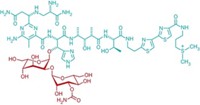Advertisement
Grab your lab coat. Let's get started
Welcome!
Welcome!
Create an account below to get 6 C&EN articles per month, receive newsletters and more - all free.
It seems this is your first time logging in online. Please enter the following information to continue.
As an ACS member you automatically get access to this site. All we need is few more details to create your reading experience.
Not you? Sign in with a different account.
Not you? Sign in with a different account.
ERROR 1
ERROR 1
ERROR 2
ERROR 2
ERROR 2
ERROR 2
ERROR 2
Password and Confirm password must match.
If you have an ACS member number, please enter it here so we can link this account to your membership. (optional)
ERROR 2
ACS values your privacy. By submitting your information, you are gaining access to C&EN and subscribing to our weekly newsletter. We use the information you provide to make your reading experience better, and we will never sell your data to third party members.
Environment
Sarcosine Risk Misinterpreted
March 8, 2010
| A version of this story appeared in
Volume 88, Issue 10
I am afraid that the comments by John Rudesill may confuse and mislead readers (C&EN, Nov. 23, 2009, page 4). Although it is true that sarcosine (N-methylglycine) is an intermediate in the environmental bacterial conversion of glyphosate (N-phosphonomethyl glycine) to glycine (J. Biol. Chem. 1987, 262, 12164; Appl. Environ. Microbiol. 1987, 53, 974), this is restricted to pure cultures of bacteria that have been selected in the laboratory to use glyphosate as a sole phosphorus source and is not generally true of bacteria in the environment.
More important, this does not represent a meaningful source of sarcosine intake for humans. Numerous detailed crop, animal, and environmental metabolism studies using carbon-14-radiolabeled glyphosate have been conducted, and sarcosine was never detected as a distinct intermediate or final decomposition product of glyphosate in soil, plants, animals, or the aquatic environment (www.fao.org/ag/AGP/AGPP/Pesticid/JMPR/DOWNLOAD/2005_rep/report2005jmpr.pdf).
Sarcosine occurs widely in foods and is endogenously produced by catabolism of dietary methionine and choline (from membrane phospholipids such as phosphotidylcholine). To date, sarcosine has no identified adverse effects following dietary intake. Humans and other mammals lack the shikimate pathway for the synthesis of aromatic amino acids, and amino acid synthesis in higher organisms is generally unaffected by glyphosate. Thus, the dietary intake of glyphosate is irrelevant to the topic of sarcosine and prostate cancer. This being said, glyphosate intake in the general population is well below levels that would trigger any safety concern, both before and after the introduction of glyphosate-tolerant crops.
The study in Nature (2009, 457, 910) has been badly misinterpreted. The authors demonstrate that prostate cells that have undergone mutation to a premalignant or overtly malignant state have, among other metabolic changes, a high production of sarcosine. Inhibition of sarcosine production appears to inhibit invasive behavior in prostate cancer cells, the mechanism of which remains undefined. The authors have not suggested that sarcosine causes prostate cancer but rather have demonstrated quite the opposite—that cancerous (or precancerous) prostate cells cause elevated levels of sarcosine. We would note in passing that the genetic inability to properly eliminate sarcosine (sarcosinemia) is biochemically recognized to occur in humans but is not associated with any recognizable phenotypic abnormality and is not known to be associated with malignancy of any type.
The suggestion that glyphosate use or exposure is related in any way to prostate cancer risk is not supported by any available literature and clearly reflects a misunderstanding of the environmental fate and mechanism of action of glyphosate and an inverted understanding of the relationship between prostate malignancy and sarcosine.
Daniel A. Goldstein
St. Louis





Join the conversation
Contact the reporter
Submit a Letter to the Editor for publication
Engage with us on Twitter